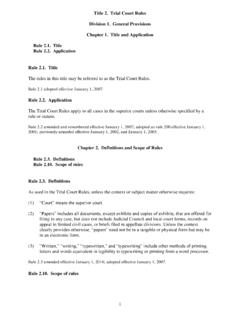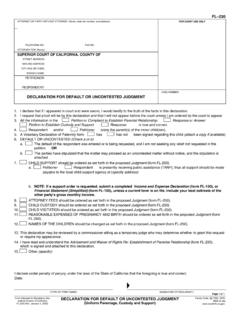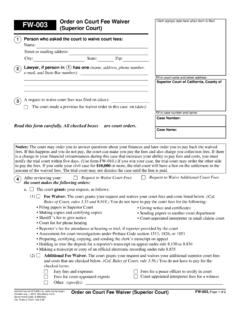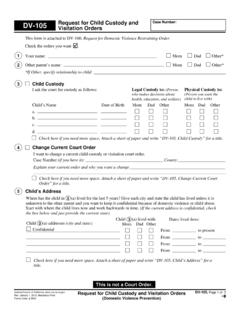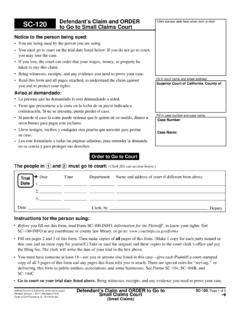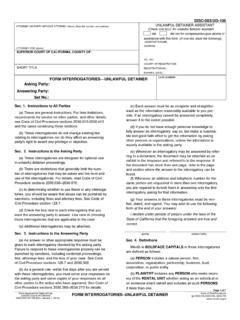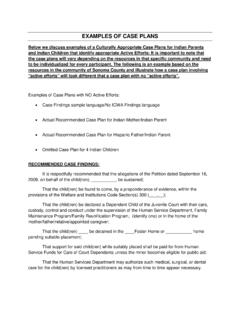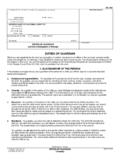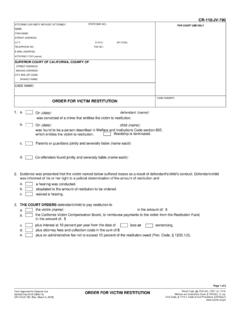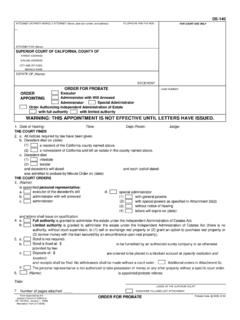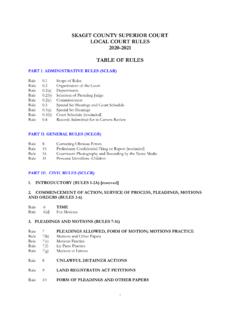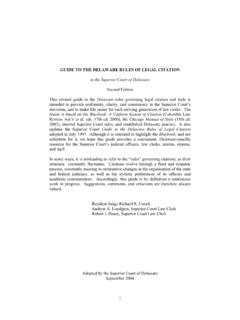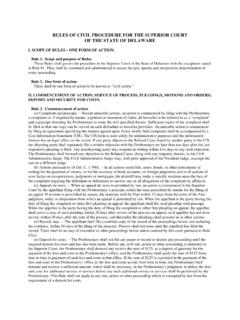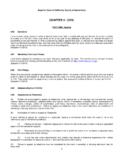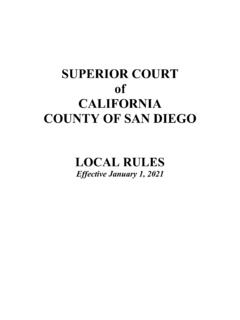Transcription of APP-150-INFO Information on Proceedings for Writs in the ...
1 This pamphlet provides general Information about Proceedings in which a person is requesting a writ a writ of mandate (sometimes called mandamus ), prohibition, or review (sometimes called certiorari ) in the superior court appellate division. Please read this form before you complete Petition for Writ (Appellate Division) (form APP-151).Judicial Council of california , January 1, 2008, Optional FormCalifornia rules of Court, rules , Page 1 of 12 APP-150-INFOI nformation on Proceedings for Writs in theAppellate Division of the superior CourtInformation on Proceedings for WritsWhat Is a Writ?General InformationThere are three main types of Writs : Writs of mandate (sometimes called mandamus ), Writs of prohibition, and Writs of review (sometimes called certiorari ).
2 These names refer to the type of order being issued: Writs of mandate are orders to do something, Writs of prohibition are orders not to do something, and Writs of review are orders providing for review of a judicial action that has already been taken. There are laws (statutes) concerning each type of writ that you should read: see Code of Civil Procedure sections 1084 1097 regarding Writs of mandate, sections 1103 1105 regarding Writs of prohibition, and sections 1067 1077 regarding Writs of review. You can get copies of these statutes at any county law library or go to 1 This pamphlet does NOT provide Information about appeals in the superior court appellate division. For Information about appeal procedures in limited civil cases, please see Information on Appeal Procedures for Limited Civil Cases (form APP-101-INFO).
3 For Information about appeal procedures in infraction cases, please see Information on Appeal Procedures for Infractions (form CR-141-INFO). For Information about appeal procedures in misdemeanor cases, please see Information on Appeal Procedures for Misdemeanors (form CR-131-INFO). This pamphlet also does not cover Proceedings for Writs of supersedeas or habeas corpus. Please see rule of the california rules of Court regarding Writs of supersedeas. For Information about Writs of habeas corpus, please see rules of the california rules of Court, and Petition for Writ of Habeas Corpus (form MC-275). You can get these rules and forms at any courthouse or county law library or go to for the rules or for the Information in this pamphlet is not intended to cover everything you may need to know about Proceedings for Writs in the appellate division.
4 It is only meant to give you an overview to help guide you through the process. You should thoroughly read rules of the california rules of Court, which set out the procedures for writ Proceedings in the appellate division. You can get these rules at any courthouse or county law library or go to rules . You are allowed to represent yourself in a writ proceeding in the appellate division. If you have any questions about the writ procedures, however, you should consult an attorney. You must retain your own attorney if you want one. You can get Information about finding an attorney on the california Courts Self-Help Center Web site at may be requested when a trial court makes what a party believes is a legal error concerning an important ruling during a case and the party believes that he or she will be harmed in a way that cannot be fixed later through an appeal if the error is not corrected.
5 The party is usually asking that the trial court be ordered to cancel (vacate) its ruling, issue a new ruling, and/or not take any steps to enforce its writ is an order (called a writ ) from a higher court directing a lower court to do something that the lower court has a legal obligation to do, or to not do something the court does not have the legal authority to do. In writ Proceedings in the appellate division, the lower court is the superior court that took the action or issued the order being challenged. In this Information sheet, we refer to the superior court as the trial court. New January 1, 2008 APP-150-INFO , Page 2 of 12 A writ proceeding is not the same thing as an appeal. An appeal is the usual way in which a party asks a higher court to review a lower court s decision.
6 But appeals can be used only to review a trial court s final judgment and certain limited orders. Most rulings made by a trial court before it issues its final judgment are not subject to immediate appeal; they can be reviewed only after the case is over, as part of an appeal of the final judgment. Writ Proceedings , in contrast, can be used to seek immediate review of important rulings made by a trial court before it issues its final judgment. Also unlike appeals, Writs are discretionary. In an appeal, the appellate division must hear the parties arguments and decide whether the appealing party is correct that the superior court made an error and whether, based on that error, the party is entitled to the relief requested (this is called a decision on the merits ).
7 In contrast, in an writ proceeding, the appellate division is not required to issue a decision on the merits; even if the superior court made an error, the appellate division can decide to leave review of that error for an appeal from the final judgment in the case. Most requests for Writs are denied without a decision on the merits (this is called a summary denial ), and courts rarely grant the relief requested even in those cases that are decided on the merits. Both because these writ Proceedings are not the ordinary way trial court decisions are reviewed and because these Writs are rarely issued, these writ Proceedings are often called Proceedings for extraordinary relief and these Writs are often called extraordinary Writs .
8 A writ proceeding is also not a new trial. The appellate division will not consider new evidence, such as the testimony of new witnesses. Instead, the role of the appellate division is to review a record of what happened in the trial court and the trial court s ruling to see if the trial court made the legal error claimed by the person requesting the writ. When it conducts its review, the appellate division presumes that the trial court s ruling is correct; the person who requests the writ must show the appellate division that the trial court made the legal error the person is claiming. Not every mistake a trial court might make can be addressed by an writ; these Writs can only address the following types of legal errors:The person requesting the writ must also show the appellate division that there is no adequate way to address the trial court's error other than through issuing a writ (this is referred to as having no adequate remedy at law ).
9 As noted above, the other, more common, way of obtaining review of a superior court ruling is through an appeal. If a superior court ruling can be reviewed either through an immediate appeal or as part of an appeal of the final judgment in the case, the appellate division will generally consider this appeal to be an adequate remedy unless the person requesting the writ can show the appellate division that he or she will be harmed in a way that cannot be fixed by the appeal (this is referred to as irreparable injury or harm) if the appellate division does not issue the trial court has a legal duty to act but refuses to exercise its power to act;The trial court has a legal duty to perform a mandatory act but has not performed that act.
10 The trial court had a legal duty to act but abused its discretion in the way it acted; orThe trial court has performed or is threatening to perform a judicial function (like deciding a person s rights under law in a particular situation) in a way that the court does not have the legal power to do. Who Are the Parties in a Writ Proceeding?2 The party that requests the writ is called the PETITIONER. The court that the petitioner is asking to be ordered to do something or not do something is called the RESPONDENT. In appellate division writ Proceedings , the trial court is the respondent. Each other party in the trial court case is called a REAL PARTY IN on Proceedings for Writs in theAppellate Division of the superior CourtInformation on Proceedings for WritsNew January 1, 2008 There are laws (statutes) that provide that certain kinds of rulings can or must be challenged using a writ proceeding.
